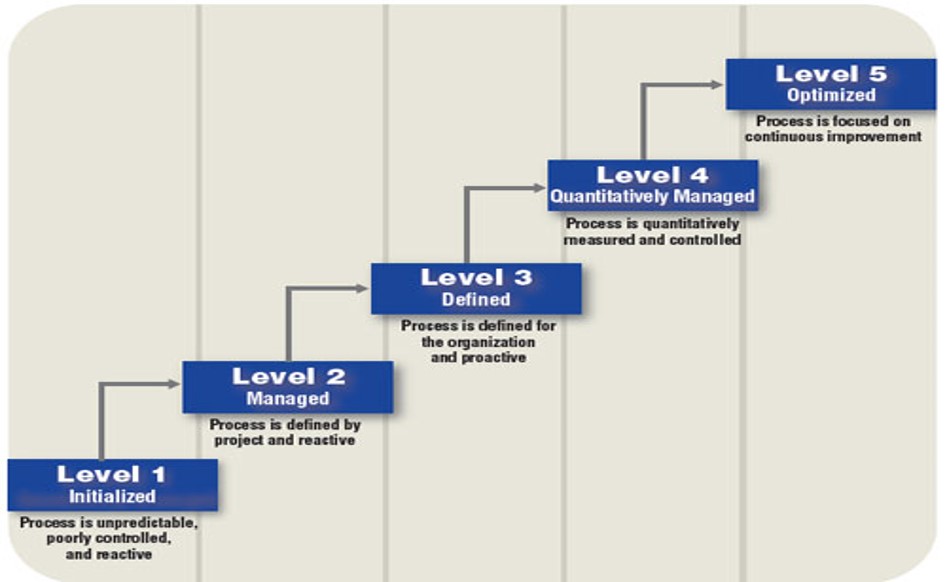Table of Contents
CMMI [Capability Maturity Model Integration]
CMMI (Capability Maturity Model Integration) is all about processes. It is a process improvement approach that examines your current processes in place and identifies their weaknesses and strengths. Then appropriate process changes, improvements and modifications are made to change these weaknesses into strengths.
CMMI model is a collection of set of very effective and reliable best practices that can help an organization improve quality, standards and efficiency. It consists of several process areas such as configuration management, project planning, etc.
Why is Capability Maturity Model Integration CMMI Model important?
CMMI model is being widely adapted by organizations to prove their efficiency and reputation. Some of the advantages of adapting CMMI model are:
It provides good RoI (Return on Investment).
When it is adapted, business sees heighted success.
It is compatible with other quality related methodologies such as 6-Sigma, ISO Standards and ITIL.
CMMI model is always improving and evolving.
Why CMMI in Test?/How does it contribute to Software Testing?
When CMMI model is implemented:
It improves quality of software delivered.
Customer satisfaction is increased.
It helps in achieving targeted cost savings.
The model also ensures stability and consistent high performance.
How can it be effectively implemented?
CMMI model does not only apply to processes. It applies to work groups, people, rules, teams and projects. To effectively implement CMMI in your organization,
Choose staff members who will be trained.
Work on creating Engineering Process Groups.
Consult with CMMI consultants.
Implement quality processes and practices.
Select appropriate tools.
Make your staff learn quality assurance, configuration management and project planning.
Introduce the CMMI model to a few projects.
Get feedback and reviews from customers
Learn and improve the practices implemented.
Add on more projects under the CMMI model.
CMMI Maturity Levels
CMMI is commonly implemented following a staged process that validates an organization across multiple different software development process areas. As an organization implements each area, it is validated on increasingly challenging CMMI maturity levels.

CMMI Level 1 assumes there is no formalized software development process in place. If a software development process exists at all, it is very ad hoc and not used in more than one project. There is very little control over the development process and a lack of metrics to compare the success of one project to another.
The focus of CMMI Level 2 is to standardize the development process in projects with similar applications. Basic project management process areas such as requirements management, configuration management, and project monitoring and control are implemented at this maturity level.By standardizing the development process across similar projects, the organization can repeat earlier successes in future projects. CMMI Level 2 is the first level most test software departments implement and contains many of the tactical processes necessary for the rest of the CMMI maturity levels.
CMMI Level 3 goes beyond standardizing the development process in particular projects and seeks to have a common software development standard across the entire organization. Each project either follows the development standard or uses an approved and tailored version of the process for developing and maintaining software.
In CMMI Level 4, the organization uses the standardized development process to define and collect detailed measures of the software and products. For example, each project can measure the rate at which software issues are resolved. By collecting these measures, the organization can quantitatively understand, control, and compare the software development process and products among projects.
Finally, CMMI Level 5 uses the measures developed in Level 4 to implement continuous process improvement based on quantitative data and determines the success of piloting innovative ideas and new technologies. For example, an organization can use the data acquired on the rate of resolution of software issues in Level 4 to statistically compare teams or projects with different tools or new processes.
Test developers not familiar with CMMI have the initial challenge of moving from CMMI Level 1 to Level 2. Whether they use a text-based development environment such as National Instruments LabWindows/CVI, a graphical development environment such as NI LabVIEW, or test management software such as NI TestStand, it is critical that they understand the components of CMMI Level 2 as well as some of the implementation challenges developers might face.


